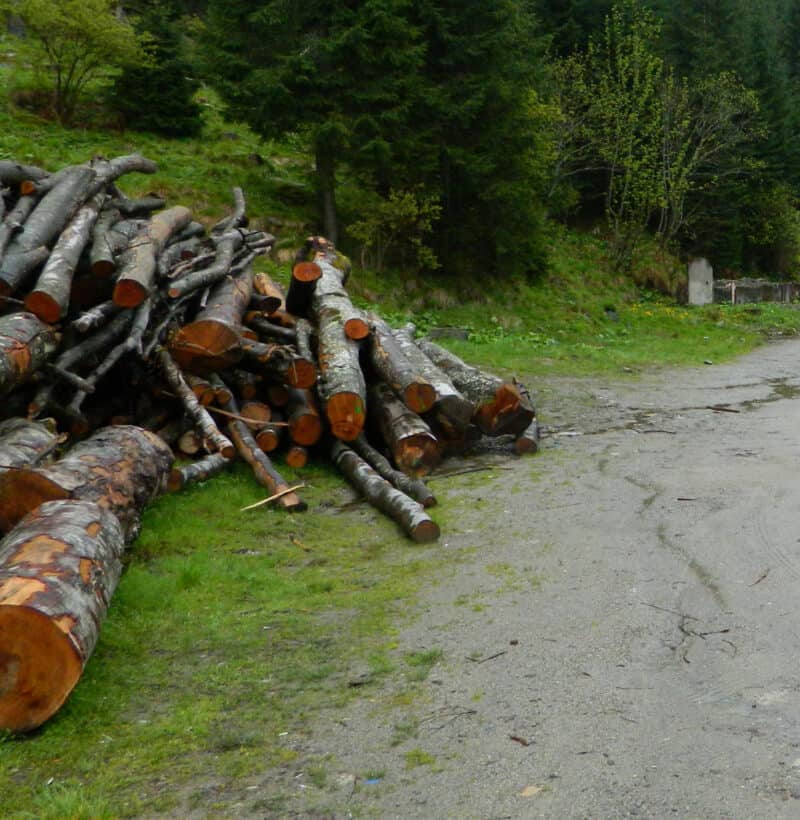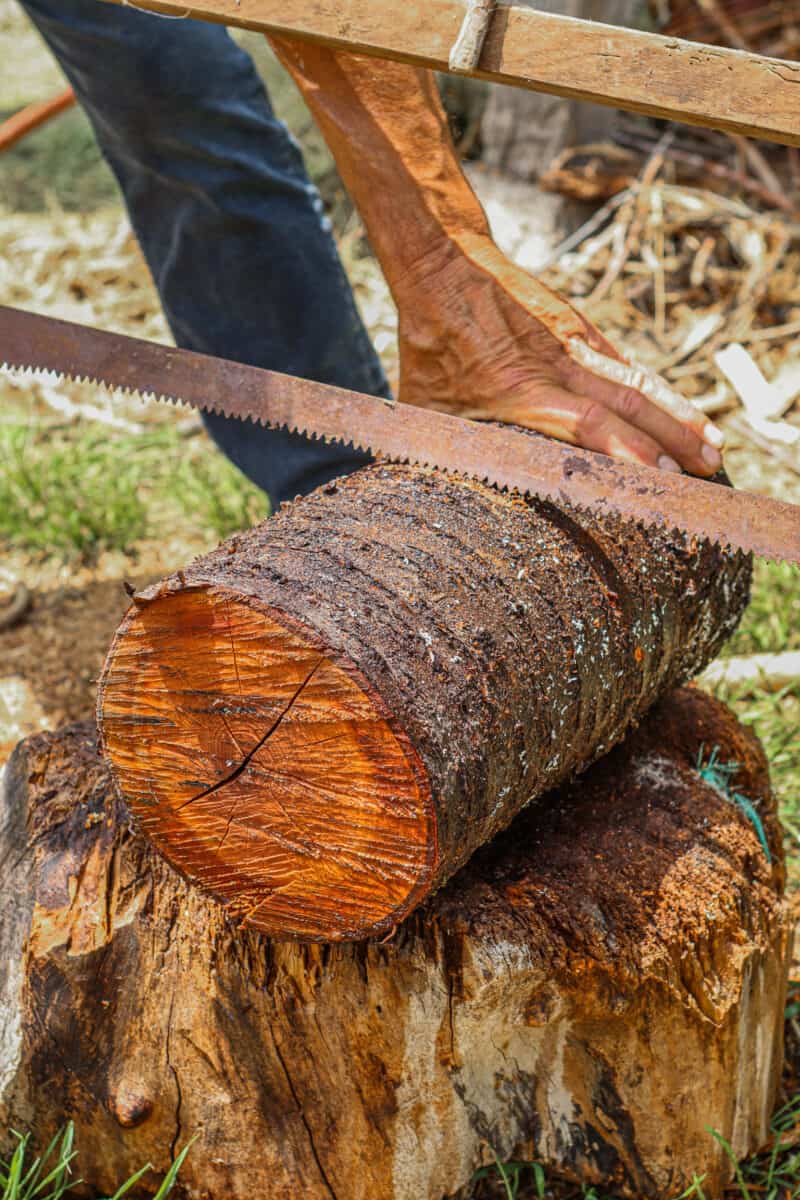Anyone who relies on wood for heating knows what a chore it can be processing a large supply. No matter what method you use, you’ll have your work cut out for you.

Some folks assert that the job can be way harder, and more dangerous, if you try to split or chop wood while it is wet.
Others say it isn’t true. What’s the real answer? Should you split wet wood?
Yes, splitting wet firewood can be done safely so long as you are cautious. Certain species of wood might be slightly harder to split when wet, but the greater danger comes from working in wet conditions.
Several methods work well for splitting wet wood, including powered log splitters, handsaws, wedges, mauls, axes and chainsaws.
Splitting wet firewood can be tricky if you don’t know what you are doing. It is important to take the necessary precautions to ensure your safety while doing so.
There are several ways to split wet wood, each with its own advantages and disadvantages. In this article, we will explore six of the most popular methods for splitting wet wood.
Does Wood Change When it Gets Wet?
Wood is an organic material that is composed of long, interlocking fibers. Even though the wood we are working with isn’t alive anymore, the fibers still influence its material characteristics.
When wood gets wet, these fibers swell up as they take on water. This causes them to become softer and pliable, allowing them to bend or flex more easily.
But when wood absorbs large amounts of water it becomes heavier and denser.
The “crowding” of the fibers might make for tougher cutting, depending on the tool and on the species of wood. However, it doesn’t make the wood impossible to cut.
When you are splitting wood, there is some potential for increased resistance when using a wedge-shaped tool (splitting), or greater difficulty when sawing (crosscutting).

However, certain species of wood actually become easier to cut or split when wet, particularly many hardwoods. This could mean that wet wood splits more easily or with less effort than dry wood.
Ultimately, whether or not the characteristics of wood change when it gets wet are mostly dependent on a number of factors inherent to the species.
So while wood getting wet can have negative consequences, you won’t be worried about your ability to split it, at least.
The Real Dangers of Splitting Wet Wood
Splitting wet wood can be extremely dangerous, but not for any reason of the wood’s characteristics when it gets wet.
The risk comes from the fact that if the wood is wet, then conditions are also likely to be wet. That is the danger!
When the ground is wet and slick, you are less able to maintain sure footing. This can make it more likely that you will slip or stumble, potentially cutting yourself or someone else with your tool.
You might also get wet in such conditions, making it harder to maintain your grip and control your tool, whatever it is. Losing control, even for an instant, can have grave consequences.
Not for nothing, the wood itself is likely to be much heavier and more cumbersome when it is wet, making it harder to control.
If your work surface is wet and slick, wet wood may also skid or shift unexpectedly if it is not secured, further increasing the risk of mishap.
So if you do need to split wet wood, or split it when the ground is wet or if the forecast calls for rain, it is important to take extra care.
As always, wear proper safety gear such as gloves, goggles, and boots with good traction. Ensure you have solid footing, and think through your moves before you commit.
By being smart about it, you can still split wet and reduce your risk of injury. That’s enough for the safety lecture.
How should you go about splitting wet firewood?
6 Safe Ways to Split Wet Wood
Log Splitter
A log splitter is a hydraulic or electrically powered machine that is used to split logs into smaller pieces, either by pressing the wood into a fixed wedge or powering a wedge through a log braced in the machine.
The advantage of using a log splitter over other methods is that it can split the wood more evenly and with no more effort than is required to load and unload the wood.
In addition, a log splitter can be used to easily split wet wood without any trouble and with far less risk to the operator compared to manual or power wood cutting tools.
There are two types of log splitters: horizontal and vertical. Horizontal log splitters are more common and orient the log parallel with the ground for processing.
Vertical log splitters are just the opposite, with the log held perpendicular to the ground. Both types of log splitters have their advantages and disadvantages.
For example, horizontal splitters are less likely to tip over than vertical splitters, but they require more space to operate.
Vertical versions are more compact and easier to store, but they may be less stable than horizontal ones.
Overall, a log splitter can be a great tool for anyone who needs to process firewood, wet or not, so long as you can keep it running.
Handsaws
A handsaw is a popular tool for processing small diameter branches (appx 2″-3″) or young trees or for prepping larger stock for processing in a wood splitter, above.
It’s also particularly useful for cutting wet wood, and you’ll be happy to know it is much safer than a chainsaw or axe, though much slower in return.
There are two types of handsaws: crosscut saws and rip saws. Crosscut saws are used for cutting across the grain of the wood, while rip saws are used for cutting along the grain of the wood.
Wet wood is easier to cut than dry wood because the water lubricates the blade and prevents it from getting stuck in the wood. In addition, wet wood is less likely to split or crack when it is being cut.
If you want to cut wood with a handsaw, there are a few things to know about going: First, understand that it is going to be a real workout unless you have only a small quantity to process.
Hand-sawing can get quite tiring.
Another thing to know is what kind of wood you are sawing: whether wet or dry, softwoods, like pine and spruce, will generally be easier to saw than hardwoods like oak and maple.
I’m not suggesting it is impossible to saw hardwoods by hand, you can, but it is hard work!
When using a handsaw on wet wood, it is important to make sure that the blade is quite sharp and that the teeth are set at the correct angle.
If the blade is not up to snuff, it will not be able to cut cleanly through the wet and flexible fibers of the wood.
It will instead “plow” or “wallow” through, if it cuts at all, and it will have no advantage over any other method.
Wedges
Wood wedges are a simple, practical tool for anyone who regularly splits firewood, and are adaptable to all kinds of processing tasks.
You can use wedges to split whole logs in two, or to break down large stock with minimal effort so long as you are patient.
A wedge is nothing more than a triangular-shaped piece of metal with a sharpened edge that is used to split wood along or “between” the grain.
One advantage of using a wedge is that it can be used to split wet wood safely without any complications, particularly large logs which might be dangerous to handle with other tools.
To use a wedge, simply drive it into the side of the log or a smaller piece with a mallet or other sturdy pounding tool.
As the crack widens, you can insert another one farther down or move the first wedge. As the new wedge is driven in, it will split the wood again to make room for yet another one.
Repeat the process until the whole log is split into two.
When choosing a wedge, it is important to consider the size of the logs that you will be splitting. For large logs, a heavier, longer wedge is often necessary to penetrate deeply enough to split the wood.
In addition, it is important to make sure that the wedge is made of strong steel that can withstand repeated blows from a heavy mallet without deforming.
Using wedges might prove to be the quickest and most efficient way to split larger pieces of wet wood safely.
Maul
A splitting maul is a hand tool that is used to split wood along the grain.
The maul has a long handle and a heavy, broad, wedge-shaped head; it looks a little like a fat axe! Mauls are ideal for splitting larger or tough pieces of firewood with one blow.
The head of the maul is usually made of steel, and it often has a wedge-shaped edge that helps to split the wood more effectively.
Compared to an axe a maul is less versatile and poorer at chopping, but it excels at this singular task.
In order to use a splitting maul, you must first position the log in such a way that it can be split evenly down the middle.
Then raise the maul above your head, like an axe, and bring it down hard on the workpiece.
With enough practice, a person can deliver accurate, powerful blows that will result in an authoritative and clean split.
Nothing beats the satisfaction of a one-swing split!
Though mauls are heavier than axes and nominally more tiring to swing, wielded properly they will require fewer blows to split any given piece of wood, saving energy in the long run.
Periodic sharpening of the maul’s edge will help to keep it in good condition.
Another advantage of using a maul when splitting wet wood is that it generally creates larger, chunky splits than other tools like axes or hatchets.
This makes it easier to reduce larger pieces into smaller ones, allowing you to stack them for easy storage.
Axes
An axe is a tool that has been used for centuries to split wood. Their heavy, sharpened heads are capable of performing all kinds of wood cutting tasks in any conditions.
The head is usually made of steel and the handle is traditionally made of wood, though synthetic materials are quite common these days.
Although very similar to the maul, axes are better at chopping through the fibers of wood, and still capable of splitting when required.
Of all the hand tools you can own for the purpose, the axe is the most versatile, no question.
To split with an axe, set up your wood just like you did with the maul. When you’re chopping firewood, make sure the log you’re cutting is supported on a raised and level surface.
You don’t want it to shoot out of the way when you strike it. You definitely don’t want to chop any wood near ground level if at all possible as your chances of hitting your own legs are greater in the event of an accident.
Though it is the picture of simplicity, it is vitally important to be aware of the potential dangers involved in using this tool.
One danger is that the axe can slip, miss or deflect and hit you if you are not cautious. Also, always keep your axe sharp.
A dull blade is more dangerous than a sharp one, since it will not only make the job harder but it also increases the risk of deflection.
Finally, be sure of your position before you swing and make sure there is nothing in the path of the axe that could be harmed in case of a miss or deflection.
Chainsaws
Chainsaws are an incredibly useful tool for splitting wood. They provide far greater power and efficiency than any hand tool, and greater versatility than power splitters.
They allow you to cut through hardwoods like oak and maple with much less effort, and are incredibly portable for what they can achieve.
Additionally, chainsaws make it easy to cut accurate and uniform pieces of firewood, which is important in order to maximize efficiency and ensure that it fits neatly inside your fireplace or stove.
There is a lot to love about a good chainsaw. And, as you’d guess from it being on this list, a chainsaw is a versatile tool that can be used to split wet wood.
Though the wet pulp or “swarf” left behind from the passage of the chain will likely cake up and stick to the saw, this is nothing to worry about and is easily cleaned up.
However, chainsaws are incredibly dangerous if used improperly, or there is a mishap. A moment’s inattention can cause serious injury or even death before you can possibly react.
When using a chainsaw to split any wood, you must follow proper operational and safety procedures.
First, make sure that you choose the appropriate type of chain based on the width and type of wood that you plan to split; larger, thicker pieces may require more aggressive teeth than thin logs or smaller branches.
Second, always be sure to wear PPE: heavy gloves, helmet, face shield or goggles, boots and cut-resistant chaps are mandatory when handling a chainsaw to protect yourself from accidents.
Second, understand that chainsaws require a lot of maintenance in order to keep them running properly and safely.
This includes sharpening the chain on a regular basis and making sure that the saw is properly lubricated.
In the end, a chainsaw can be your quickest and most versatile tool for processing wet wood, but you must never be complacent when using it.
You Can Split Wet Wood Safely
Splitting wet wood is a dangerous prospect to some, but it really isn’t as long as your work area is suitable and tools are handled safely.
We’ve provided an overview of the most popular methods for splitting wet wood with both hand and power tools.
As long as you use caution and common sense in wet conditions you’ll be able to easily split wet wood no matter the size.

Tom has lived and worked on farms and homesteads from the Carolinas to Kentucky and beyond. He is passionate about helping people prepare for tough times by embracing lifestyles of self-sufficiency.

Two things I would like to add if I may: 1. In the northern climates where it freezes hard, it tends to be beneficial to split the wet (frozen) wood as the pressure from the expanding ice in the wood tends to help. Just like water in a glass will break it as the water freezes. At least that has been my experience when splitting wood. 2. When splitting a large diameter log, say 20″ or more, you may want to split the edges off, instead of trying to split it down the middle. When the log is now smaller then wack away through the middle. When I was younger I had buried as many as 4 steel wedges in a big log that still didn’t split. At least I finally learned.